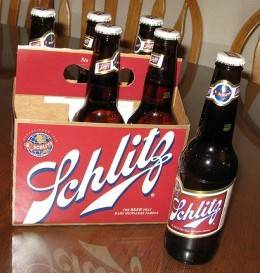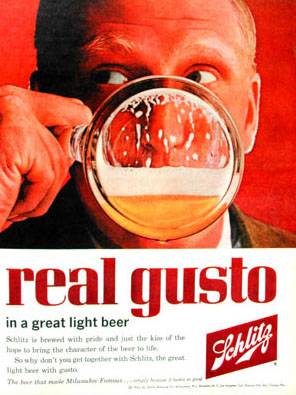 On a recent visit to Piccadilly, I noticed Schlitz six-packs prominently displayed with a number of other newly-arrived, quality, American craft beers. This caught my eye for a few reasons. First, Schlitz usually isn’t displayed with quality craft brews. Second, I haven’t seen a sixer of Schlitz bottles in years. And third, the packaging seemed a little different. I picked up a bottle to have a closer look and discovered, according to the label on the bottle, that I was holding a “classic 1960s formula” Schlitz.
On a recent visit to Piccadilly, I noticed Schlitz six-packs prominently displayed with a number of other newly-arrived, quality, American craft beers. This caught my eye for a few reasons. First, Schlitz usually isn’t displayed with quality craft brews. Second, I haven’t seen a sixer of Schlitz bottles in years. And third, the packaging seemed a little different. I picked up a bottle to have a closer look and discovered, according to the label on the bottle, that I was holding a “classic 1960s formula” Schlitz.
Quite a few questions raced through my mind. Has the success of the micro-breweries choosing to focus on releasing a quality product influenced the big guys to improve their product, or is Schlitz jumping on the pseudo-micro bandwagon like Budweiser is doing with their American Ale? Is Schlitz trying to revive their beer with younger drinkers like Pabst Blue Ribbon did at the beginning of this decade, or is this just a big marketing gimmick? I figured that I’d need to research this issue in order to answer these questions. Of course, the research would involve testing out the new “old” Schlitz.
The first stop in my research was the Schlitz website. The home page broadly proclaims “Schlitz Classic ’60s Formula is Back!” I followed the prompt to learn more. Here I was informed that the new formula “recalls the original hearty taste of the classic 1960s Schlitz — a true Pilsner, perfectly balanced between full-flavor and easy drinking, with just a kiss of the hops.” Sounds good so far, though easy drinking is the only description I associated with the un-classic formula Schlitz. In the past I picked up a 12-pack of Schlitz cans because, like PBR, Stag or Old Style, the price was right, it got the job done and it tasted better than Budweiser. Other than the one sentence description of the revamped beer, I was not able to get any more specifics about the 1960s recipe from the Schlitz site.
 Schlitz does play up the nostalgia aspect on their site. While the featured vintage commercials and advertisements are nifty, proclamations such as “The Girls Were Hotter,” “There Cars Were Cooler” and “The Music Didn’t Suck” obviously speaks more to wacky marketing than the actual product. I couldn’t help but feel at this point in my research that Schlitz is trying to horn in on the younger and allegedly hipper beer drinking crowd through corny catchphrases and painful attempts at irony. Pabst Blue Ribbon experienced a resurgence in sales in the early 2000s from drinkers in their twenties discovering PBR as a decent economy beverage, and (unfortunately) for some it became a statement of irony because they were drinking an antiquated brew that they associated with their dad or gramps. Later, PBR capitalized on this trend through hip demographic-specific advertisements and merchandise catering to hip fashion of the minute. Seeing as Schlitz is owned by Pabst, it makes sense that they would try this marketing angle with a new product.
Schlitz does play up the nostalgia aspect on their site. While the featured vintage commercials and advertisements are nifty, proclamations such as “The Girls Were Hotter,” “There Cars Were Cooler” and “The Music Didn’t Suck” obviously speaks more to wacky marketing than the actual product. I couldn’t help but feel at this point in my research that Schlitz is trying to horn in on the younger and allegedly hipper beer drinking crowd through corny catchphrases and painful attempts at irony. Pabst Blue Ribbon experienced a resurgence in sales in the early 2000s from drinkers in their twenties discovering PBR as a decent economy beverage, and (unfortunately) for some it became a statement of irony because they were drinking an antiquated brew that they associated with their dad or gramps. Later, PBR capitalized on this trend through hip demographic-specific advertisements and merchandise catering to hip fashion of the minute. Seeing as Schlitz is owned by Pabst, it makes sense that they would try this marketing angle with a new product.
When I spoke with Preston Wright, a bartender at the Esquire Lounge in downtown Champaign, he also questioned the marketing tactics used by Schlitz to rope in the hipster drinking crowd. Preston pointed out that while PBR found its niche with younger drinkers through affordability, the new classic Schlitz isn’t exactly cheap. The new Schlitz goes for $3.50 a bottle at the Esquire. Compared to Schlitz’s traditional shelf mates at the Esquire — Old Style pints for $1.50, PBR cans at $1.50 and Strohs cans for $1.00 — it looks like Schlitz is trying to go uptown.
Despite the increased price, the new Schlitz has been selling at a moderate pace at the Esquire. It was currently out of stock at the time of my visit and the Esquire has restocked it twice since the classic Schlitz hit the street. Preston said that customers who have ordered Schlitz have expressed nostalgia about drinking it years ago. Apparently, the nostalgia marketing seems to be working with the seasoned drinkers.
With my skepticism growing, I was happy to run across a Beer Advocate article that provided additional insight into the new Schlitz. According to the article, Schlitz’s bottler, Louis Glunz Beer, Inc., hopes that the return of the full bodied beer, brown long neck bottles and classic logo will revitalize Schlitz as the quality product it used to be. In the early ’70s Schlitz watered down the beer to compete with the growing success of Busch and other body-less lighter beers. In order to regain its former glory, Pabst’s Brewmaster, Bob Newman, interviewed retired Schlitz employees in order to re-create the old recipe. The Beer Advocate article also presented the intentions behind the Classic Schlitz as sincere.
At this point, I figured I needed to make the final decision by “going to for the gusto” myself. I stopped back in at the Piccadilly on Neil and Healey. I asked Assistant Manager Ben Masson’s opinion of the classic Schlitz. “It’s not just a clever marketing scheme,” said Masson. “You can really taste the difference between the new bottles of Schlitz and the old cans. The bottle has a more full flavor and the cans are watery.”
The customer response has been positive too. Piccadilly, which is one of the only stores in Champaign-Urbana selling the classic Schlitz at this time, is going through at least five cases a week. Masson described the classic Schlitz customers as “guys who drank it in the ’60s and ’70s. A couple guys regularly buy it by the case.” Well, that shoots down my marketing-to-the-hipster theory.
I picked up a sixer for $5.99. Back home, once I felt the bottles were sufficiently cold, I cracked open a beer that made Milwaukee famous. It had been a few months since I had tasted Schlitz in a can, so I wondered if my palate could sense anything different. I noticed a difference immediately. The classic 1960s formula definitely has more flavor and is not nearly as watery as it used to be. The body is on par with a Leinenkugels. Did it knock my socks off? Not really. Was it enjoyable? Definitely. Would I drink it on a regular basis? Possibly, if sixers were a dollar cheaper. Overall, I was pleasantly surprised to discover that the classic-recipe Schlitz holds up fairly well to its own hype. Here’s to a return to quality. Hopefully, we’ll see other beers follow suit.








